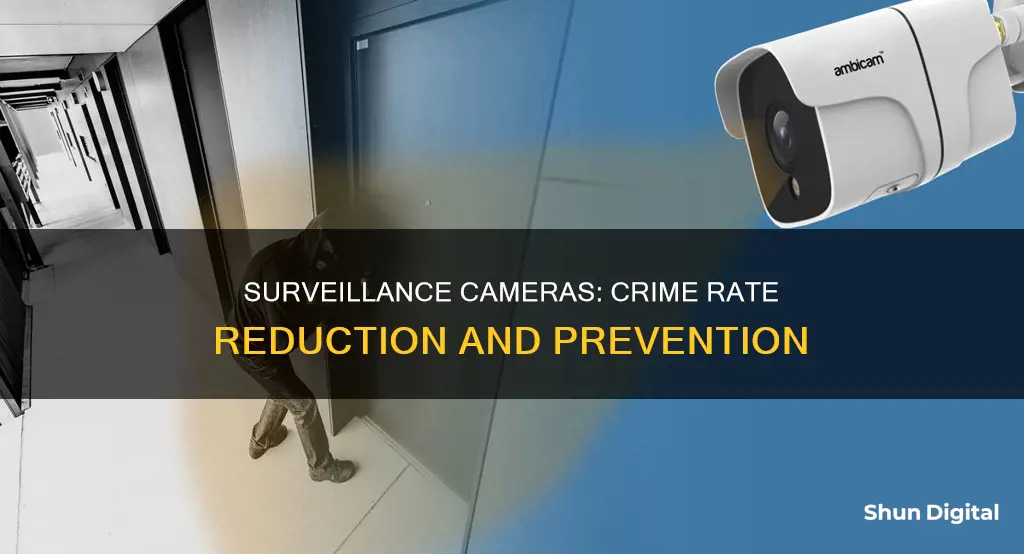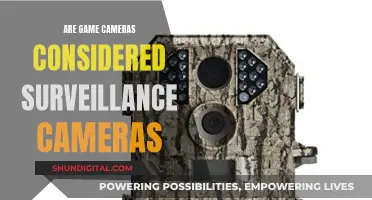
The presence of surveillance cameras has been a topic of debate regarding the balance between privacy and security. However, their impact on crime rates cannot be ignored. Surveillance cameras act as a deterrent to potential criminals, leveraging the psychological effect of being watched or the risk of being recorded. Case studies have shown significant drops in petty crimes like theft and vandalism in areas with widespread surveillance systems. For instance, surveillance cameras installed in Orange County, New Jersey, led to a 50% decrease in all types of crimes. Additionally, advanced technologies like artificial intelligence and machine learning have further enhanced the effectiveness of surveillance, enabling real-time detection of suspicious activities and quicker responses. While the debate around privacy concerns continues, the contribution of surveillance cameras in reducing crime rates and fostering a sense of safety among communities is evident.
What You'll Learn

Surveillance cameras act as a deterrent
Surveillance cameras can act as a powerful deterrent to crime. The presence of security cameras suggests a higher risk of being caught, which is often enough to prevent crime before it happens. They send a clear message to wrongdoers that they are being watched. This is known as the "deterrence effect".
The placement of cameras in high-visibility and high-risk areas is crucial. Visible camera signs also contribute to this effect, as they create a perception of surveillance and make individuals think twice before committing a crime. This psychological deterrence is particularly effective in areas with a demonstrated commitment to surveillance technology.
The fear of being identified and apprehended is a significant factor in discouraging criminal behaviour. Criminals do not want to be seen or recorded, and the prospect of having evidence against them is a powerful deterrent. This is especially true for burglars, who often seek out easier targets that do not have security measures in place.
The installation of surveillance cameras in specific locations, such as parking lots or public transportation hubs, has been shown to lead to a reduction in certain types of crimes in those areas. For example, the city of East Orange, New Jersey, experienced a 50% drop in all types of crime after installing security cameras.
Surveillance cameras are a modern-day scarecrow for criminals, creating a digital force field that protects businesses and homes. They are a crucial component of a comprehensive security strategy, complementing other measures such as alarms and security personnel.
Camera Battery Control Board: What's Inside?
You may want to see also

They help solve crimes
Surveillance cameras are an invaluable tool for law enforcement agencies, aiding them in solving crimes and preventing future ones. They provide hard evidence that is objective and reliable, which is crucial for investigations. Here are some ways in which surveillance cameras help solve crimes:
Hard Evidence and Investigative Leads
Surveillance cameras provide law enforcement with concrete evidence, which is essential when investigating a crime. This evidence can include video footage, images, and other relevant data captured by the cameras. For example, in a case involving 13 car break-ins in Wentzville, Missouri, police obtained images, a more precise timeframe, a vehicle description, the number of suspects, and a map of their movements through the neighbourhood. This information helped them retrace the suspects' steps and search for additional evidence.
Corroborating Other Evidence
Security cameras are also used to validate other types of evidence and ensure the accuracy of the fact pattern based on physical evidence at the crime scene. For instance, in the case of a business burglary, security camera footage can confirm that a suspect broke a window from the outside and entered the premises. This corroboration strengthens the case, leading to higher conviction rates and more severe consequences for criminals.
24/7 Surveillance and Eyewitness Substitute
Most security cameras operate continuously, providing a record of any activity within their field of view, regardless of the time of day or night. This 24/7 surveillance compensates for the lack of reliable eyewitnesses, who may not always be present at the scene of a crime. Additionally, modern security cameras often have advanced features such as high-quality night vision, high-definition recording capable of capturing license plates, and motion detection, further enhancing their usefulness in investigations.
Crime Prevention and Deterrence
The presence of surveillance cameras can deter criminal activity and prevent crimes from occurring in the first place. Criminals typically avoid areas under surveillance to minimise the risk of being identified and apprehended. In Orange County, New Jersey, the installation of surveillance cameras resulted in a 50% drop in all types of crimes. This decrease in crime rates underscores the effectiveness of surveillance cameras as a crime prevention tool.
Surveillance cameras play a crucial role in both solving crimes and deterring potential offenders. They provide law enforcement with valuable evidence, corroborate other types of evidence, offer continuous surveillance, and serve as a visible deterrent to criminal activity. By leveraging the capabilities of surveillance cameras, law enforcement agencies can enhance their investigative capabilities and improve the overall safety of the communities they serve.
Flying with Camera Gear: Safely Transporting Lithium-Ion Batteries
You may want to see also

They can reduce property crime
Surveillance cameras can be an effective tool in reducing property crime, which includes burglary, armed robbery, theft of motor vehicles, and arson. Here are several ways in which surveillance cameras can help reduce property crime:
Deterring Criminals
Surveillance cameras can deter criminals from targeting certain areas or properties. Criminals typically avoid being seen or recorded, so the presence of cameras can discourage them from attempting a crime. In a study by the University of North Carolina, 60% of surveyed burglars indicated that they would move on to another target if they encountered an alarm system or security cameras. Similarly, a local television station in Oregon, KTVB7, interviewed 86 inmates serving time for burglary, and most of them stated that they would leave immediately if they saw security cameras on the property.
Assisting Investigations and Apprehensions
Surveillance cameras provide valuable evidence that can assist in investigations and lead to the successful identification and apprehension of suspects. For example, in the Boston Marathon bombing investigation, video footage from public surveillance cameras helped investigators identify the two suspects. This capability can act as a deterrent, as criminals are aware that their chances of being caught increase significantly when surveillance footage is available.
Increasing Sense of Security
The presence of surveillance cameras can enhance the sense of security for homeowners and the general public. This sense of security is further bolstered by the knowledge that security cameras not only help detect crimes but also actively deter them.
Reducing Costs Associated with Property Crime
The use of surveillance cameras can lead to a reduction in the costs associated with property crime. In Chicago, for instance, the cost savings from crimes averted through camera systems were estimated to be four dollars for every dollar spent on the technology. This includes potential savings in insurance costs, as a wireless camera security system can lead to reduced homeowner's insurance rates due to enhanced security.
Enhancing Crime Prevention Strategies
Surveillance cameras, when combined with other security measures, can create a more comprehensive crime prevention strategy. For example, outdoor lighting, particularly motion-activated lighting, can work in tandem with cameras to increase the visibility of criminals and deter criminal activity. Additionally, security signs can also be effective, with one in four burglars indicating that they would move on if they saw security signs across a property.
In summary, surveillance cameras can be a valuable tool in reducing property crime by deterring criminals, assisting in investigations, enhancing the sense of security, reducing associated costs, and strengthening overall crime prevention strategies.
Mastering Camera Focus: Disabling the Rectangle Assistant
You may want to see also

They can deter violent crime
Surveillance cameras can be an effective tool in deterring violent crime and enhancing public safety. Their presence can discourage potential offenders from engaging in violent acts as no one wants to be watched or recorded during the commission of a crime. This sense of being monitored can act as a powerful deterrent, making individuals think twice before partaking in any violent behaviour.
The effectiveness of surveillance cameras in deterring violent crime has been demonstrated in various studies. For example, in Orange County, New Jersey, the installation of surveillance cameras resulted in a 50% decrease in all types of crime across the city. This significant drop included violent crimes, making it evident that surveillance cameras can play a pivotal role in deterring such offences.
Additionally, the University of North Carolina in Charlotte conducted a comprehensive study involving 422 imprisoned burglars. The majority of these offenders, 60% to be precise, asserted that they would actively look for the presence of an alarm system or security cameras before considering breaking into a house. This finding underscores the notion that surveillance cameras serve as a substantial deterrent, causing potential criminals to reconsider their actions or seek alternative targets.
The benefits of surveillance cameras extend beyond mere deterrence. They also aid in the investigation and resolution of violent crimes. Law enforcement officials can utilise camera footage to identify suspects, gather evidence, and build strong cases for prosecution. This not only helps bring perpetrators to justice but also acts as a preventive measure, sending a clear message that violent crimes are more likely to be solved and punished due to the availability of visual evidence.
Surveillance cameras, when employed responsibly and with respect for privacy, can be a valuable tool in the fight against violent crime. They provide a sense of security and peace of mind to citizens, knowing that their safety is being proactively monitored and addressed. While privacy concerns are valid and should be carefully considered, the potential life-saving benefits of surveillance cameras in deterring violent crime cannot be overlooked.
RAW Photography: Mastering ISO Sensitivity
You may want to see also

They foster a sense of safety
Surveillance cameras foster a sense of safety in several ways. Firstly, they act as a deterrent to potential criminals, reducing the likelihood of crimes being committed. The presence of cameras can make criminals feel uneasy, as they do not want to be seen or recorded, and this can discourage them from targeting a particular area. This sense of security is especially important in high-risk areas such as clubs, shopping centres, and busy transport hubs.
Secondly, in the unfortunate event that a crime does occur, surveillance cameras can aid in catching the perpetrator. Facial recognition software, combined with the wide reach of surveillance networks, increases the chances of identifying and locating criminals. This can lead to a sense of safety for the general public, knowing that the chances of getting away with a crime are lower.
Additionally, surveillance cameras can provide valuable evidence in court. Footage of a crime can be used to support investigations and prosecutions, leading to a higher chance of a successful conviction. This not only brings justice but also helps to foster a sense of safety and trust in the legal system.
Surveillance cameras also assist law enforcement in monitoring and responding to crimes in real time. Access to live footage enables police to make more informed and timely decisions, potentially preventing crimes in progress and improving the efficiency of their responses.
Lastly, surveillance cameras can provide peace of mind to individuals, especially in their homes. The knowledge that one's property is being monitored can alleviate fears and create a sense of security. However, it is important to note that this sense of safety may come at a cost to privacy, and individuals must carefully consider the trade-offs involved.
Canon Cameras: Self-Focusing Mastery
You may want to see also
Frequently asked questions
Surveillance cameras have been shown to be effective in reducing crime rates, particularly in specific contexts such as parking lots and public transit systems. In Orange County, New Jersey, surveillance cameras led to a 50% drop in all types of crimes. Advanced technologies like artificial intelligence (AI) and machine learning have further enhanced the efficiency of crime prevention and enabled quicker responses.
Surveillance cameras are particularly effective in deterring and reducing petty crimes such as theft, robbery, and vandalism. They also contribute to a reduction in property crimes by making it riskier for criminals to operate, thus protecting personal and commercial assets.
Security footage is an indispensable tool for law enforcement, aiding in investigations and providing evidence in court. It improves the clarity and availability of video evidence, making it easier to solve crimes and prosecute perpetrators. Surveillance cameras also assist in monitoring public spaces, fostering a sense of safety and security among community members.







